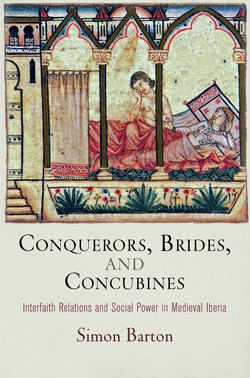Conquerors, Brides, and Concubines

Реклама. ООО «ЛитРес», ИНН: 7719571260.
Оглавление
Simon Barton. Conquerors, Brides, and Concubines
Отрывок из книги
Conquerors, Brides, and Concubines
Ruth Mazo Karras, Series Editor
.....
Unfortunately, however, our sources have practically nothing to tell us about the circumstances that gave rise to such cross-border marriage alliances. It is probably safe to assume that for the most part freeborn Christian brides were not party to the negotiations that preceded such matrimonial pacts and that their consent was rarely sought, although that did not necessarily mean that all female members of the family were completely excluded from such deliberations.85 No marriage contracts survive, more is the pity, nor are we left with even a description of how, in the case of freeborn Christian women, the undoubtedly delicate negotiations that preceded the marriage might have been conducted between the two parties. However, a glimpse of such matters is provided by the brief and idiosyncratic Chronicle of the Kings of León, which was composed by Bishop Pelayo of Oviedo sometime between 1121 and 1132.86 In his unremittingly hostile account of the reign of Vermudo II of León (982–99), the bishop makes fleeting reference to the marriage alliance that was subsequently arranged “for the sake of peace” between the king’s daughter, Teresa Vermúdez, and a certain pagan (i.e., Muslim) king of Toledo by her brother Alfonso V (999–1032). According to Pelayo, the princess proved an unwilling participant in the marriage, and when the king mocked her protests and subsequently raped her, he was struck down by a vengeful angel. On his deathbed, the king ordered that Teresa be allowed to return to her Leonese homeland. It was there that she took a nun’s habit and later died in Oviedo, where she was buried in the monastery of San Pelayo.87
We shall return to the ideological significance of this episode in a later chapter. For now, it is the historicity of Pelayo’s account that concerns us.88 Documentary sources confirm that there was indeed a Princess Teresa born to Vermudo II and his second wife Elvira García of Castile. She can first be traced in the records on 18 August 1017, when she confirmed a grant made by her mother, Queen Elvira, to the bishop and chapter of Santiago de Compostela; on 17 December of that same year, with her sister Sancha Vermúdez, she engaged in a lawsuit with one Osorio Froilaz over the monastery of Santa Eulalia de Fingoy.89 On 1 March 1028, Teresa granted some property of her own in the city of León to the church of Santiago; and on 27 January 1030, again with her sister Sancha, she gave an estate at Serantes to the same see.90 These Compostelan documents were later copied into the twelfth-century cartulary known today as Tumbo A, and a painting of the two sisters was added.91 In both donations Teresa was styled Christi ancilla, which demonstrates that by 1028 she had joined a religious community, in all probability that of San Pelayo de Oviedo, as Bishop Pelayo tells us, which is where she died on Wednesday 25 April 1039, according to her epitaph.92 However, no documentary record of Teresa’s supposed marriage to a Muslim king has survived.
.....